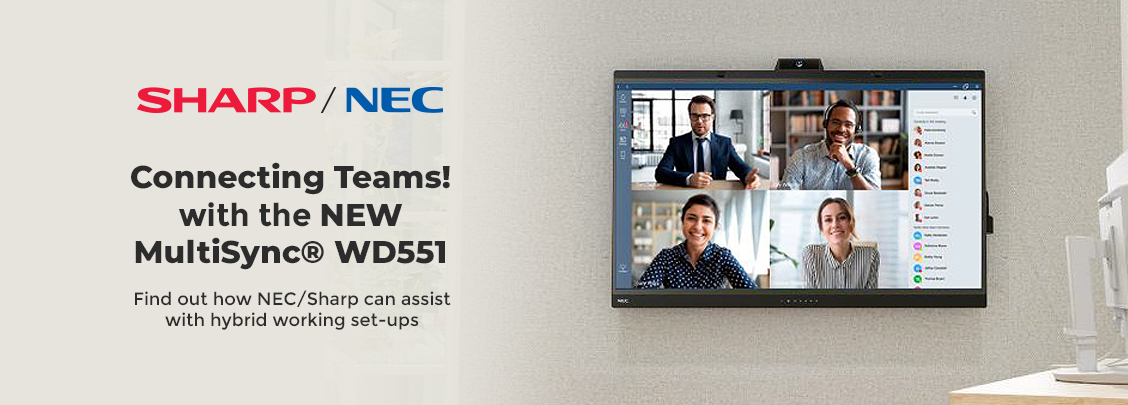Connecting Teams With Sharp/NEC: An Interview With Chris Southern
It’s no secret that hybrid working has become the ‘new normal’ for many businesses since the start of the COVID-19 pandemic. Although many of us were thrust into remote working with virtually no choice or planning time, moving forward, businesses must take what they have learnt and invest in key technology that will support a hybrid workforce.
Simon Hayes, Meeting Room and Collaboration Specialist from Sharp/NEC sat down with Chris Southern, General Sales Manager at Enterprise Solutions to discuss the technical challenges surrounding hybrid working.
How Can Businesses Achieve A Balanced Remote And In-office Hybrid Workforce?
2020 was for many of us about working from home, but some workers just don’t have the space to work from home anymore, they miss working in an office environment, or they struggle to blur the lines between their professional working life and personal life when working from home. As a result, businesses are looking for technology that supports a ‘work from anywhere’ concept.
In-person meetings will continue to be vitally important to business and providing a space for creative thinking and where collaboration is key. Investing in the right technology will enable remote participants to feel part of the physical meeting as if they were in the room too. But it’s equally important to create a welcoming, comfortable and safe space for in-office workers.
According to Chris:
"I believe the future is flexible spaces which can adapt to changing needs and can easily accommodate different group sizes with social distancing and environmental conditions remaining an important consideration for comfort and wellbeing”.
One way to achieve this is using sensor technology which can manage meeting room parameters by optimizing air quality and matching usage to capacity.
But wherever you call your desk, whether it’s in the office, on the kitchen table, or in a coffee shop, Chris believes that “the key is to ensure that wherever your workforce are, they feel connected”.
What Is The Biggest Issue Workers May Face In A Hybrid Meeting Room?
Connectivity is the most important factor of a hybrid workforce. Meeting room AV equipment should be there to help workers do their job, but it often has its glitches such as a jumble of cables, a need for an adapter, a lost remote control, or no signal.
Straightforward technology that gets the job done is the answer to meeting room issues, especially considering that many IT departments are notoriously resource-stretched. A simple connection that ‘just works’ is essential, and a hard-wired solution is often the best.
A further way to relieve the demand for IT is if remote workers can access already-familiar tools and applications, meaning they will need less training and additional support. Standardisation of the technology will allow users to become more familiar with the setup, which will equally support and take the pressure off overly stretched IT teams. This will benefit the traditional in-office workers too as they can continue to use what they are comfortable with, preventing intimidation and resistance to change. This is where Bring Your Own Device (BYOD) and Bring Your Own Meeting (BYOM) initiative have been so influential, says Chris:
“By plugging in their own laptop or tablet, workers continue to use their familiar interface, just on a much bigger screen which can be shared with other meeting participants”.
Is It Possible For Remote Workers To Feel As Engaged And Valued As Their In-office Colleagues?
Our collective lockdown experiences have helped to normalise video meetings. Everyone feels less awkward and more comfortable with the camera on. However, the next step is ensuring high-quality audio and visual experiences. Luckily, there are many tools and devices to choose from but opting for a solution that has been certified by Microsoft or Zoom will be familiar to users and provide a high-quality experience. Ultimately Chris believes:
“If you can be seen and heard as if you were in the room with your colleagues, this is the next best thing to being there yourself”.
How Can Sharp/NEC Help Businesses With The Changing Workplace Landscape?
A huge advantage of Sharp/NEC is the breadth of its offering and how it can customise an entire solution to perfectly match the needs of an application. The NEC WD551 Windows Collaboration Display is significant when discussing the challenges of a hybrid workforce. The all-in-one smart solution supports BYOM scenarios as users simply have to connect their own device using one cable, to immediately share content and start video meetings using familiar tools like Microsoft Teams.
For more information on how the Sharp/NEC WD551 could connect your team:
